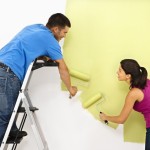So the plastering is all done, dried and ready for paint. Hopefully you will be hiring a professional painter, if not then here are a few tips to help it come out nice.
So the plastering is all done, dried and ready for paint. Hopefully you will be hiring a professional painter, if not then here are a few tips to help it come out nice.

2) Once your finishes have dried, I recommend for both the one coat and two coat plaster system that you wipe down your walls lightly with a soft rag such as a cloth diaper or dish towel. This will remove and dust or grit that may of stuck to your hard but still damp plaster.
3) Make sure the paint roller you are using spins freely. If you are using new roller sleeves it is recommended that you wash them and let them dry. Washing your rollers will help to get any loose fibers out of the rollers so they do not end up in your paint.
4) An experienced painter may or may not lightly sand plaster walls depending on how smooth/slick they are to help ensure good primer penetration into the plaster and to make sure that the roller will roll instead of sliding. Needing to lightly sand plaster walls is more common with one coat plaster then it is with two coat. If you find a need to sand the walls use 330 grit or finer and sand it very lightly.
5) CAUTION: Be advised that if painting plaster walls you must get a primer for plaster, if you don’t you run the risk of having the paint peel off the wall. So remember to let the paint store know you are painting new plaster. My neighbor, who is now a union painter does not like the new paints that already have a primer in them.
6) Once you have primed your walls look them over closely for any blemish that may need to be touched up with some joint compound. Make sure that you lightly sand any blemishes that you may have had to touch up.
7) If your plaster bumps up against a tub, back splash and sometimes trim or other surfaces not designed to adhere to plaster or joint compound it is recommended that a thin bead of paintable silicone caulking can be applied to prevent what are called separation cracks from appearing. These cracks occur when vibration occurs such as doors closing in the case of trim or the swelling and contraction of dissimilar materials occur due to temperature and humidity changes. This is especially critical when there is the risk of water penetrating around tubs and sink.
8) Apply two coats of your finish paint allowing the first to dry sufficiently before applying the second coat.
9) When it comes to textured plaster finishes the manufacture states that these also be sealed with paint, however having said that most people choose not to do so. Understand that textured paint is more porous then smooth plaster which will allow bug guts, grease, soap and other material to penetrate which can make painting it at a later date difficult. This is as true for joint compound textures as it is for plaster textures.
10) Another tip is professional painters usually pour their paint through a filter to remove any small impurities to ensure a smooth flat finish.